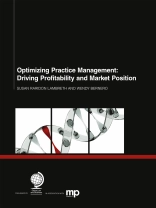As law firms have grown larger and client problems have become increasingly complex, effective practice management has become the primary vehicle through which firms seek to deliver value to clients and differentiate themselves in a competitive market.
Optimizing Practice Management: Driving Profitability and Market Position is intended to help firm leadership work through all the critical aspects of structuring and implementing an effective and optimized practice management system.
The book is divided into five main sections, covering:
The business case for practice management;
Building the essential foundation;
Developing the structure;
Keys to successful implementation; and
The role of the practice leader.
This book will help law firm leaders to:
Gain clarity on how to improve their market position and enhance the value perception of their services;
Establish the optimal practice management structure to facilitate achievement of the firm’s strategy and market position;
Focus on particular practice specialties and subspecialties, and on clients or industries, where the firm can establish a sustainable competitive advantage;
Define clearly the role of business unit leaders and members; and
Align incentives to encourage the level of collaboration that clients are demanding.
Detailed appendices contain the results of original research on practice management in the largest US law firms, and sample job descriptions for practice group leaders/members, based on the authors’ experiences working with over half of the Am Law 200 law firms.
表中的内容
About the authors ……………………………………………………………………………………VII
Preface ………………………………………………………………………………………………….IX
Foreword and acknowledgments ………………………………………………………………. XIII
Executive summary ………………………………………………………………………………… XV
Chapter 1: Practice management – An overview ………………………………………………1
1.1 Setting the stage ………………………………………………………………………. 1
1.2 History of practice management …………………………………………………….. 2
1.3 Practice management defined ……………………………………………………….. 4
1.4 The business case for practice management……………………………………….. 4
Chapter 2: The foundation for effective practice management …………………………… 11
2.1 Firm strategy ……………………………………………………………………………11
2.2 Governance and management …………………………………………………….. 13
2.3 Leadership ……………………………………………………………………………. 18
2.4 Compensation ………………………………………………………………………. 19
2.5 Partner buy-in …………………………………………………………………………. 25
Chapter 3: Implementing the foundational elements …………………………………………29
3.1 The institutional model ……………………………………………………………….. 29
3.2 The talent model ………………………………………………………………………31
3.3 The business unit model …………………………………………………………….. 32
Chapter 4: Developing an effective practice management structure ……………………..35
4.1 Selecting the primary dimension of management ……………………………….. 35
4.2 Matrix management structures as firms grow more complex …………………… 42
4.3 Size and make-up of groups ………………………………………………………. 44
4.4 Requirements and standards for business unit membership ……………………… 45
Chapter 5: Making practice management work ……………………………………………..49
5.1 Interrelationship between practice management, firm functions, and systems .. 49
5.2 Management supervision and support of the practice structure ………………… 50
5.3 Measuring business unit success …………………………………………………… 53
5.4 Avoiding missteps in implementing effective practice management ……………. 54
5.5 Case studies of two exemplary firms implementing practice management …… 57
5.6 Q&A with a successful practice leader …………………………………………… 60
Chapter 6: Leadership of business units ………………………………………………………..65
6.1 Selection of business unit/practice leaders ……………………………………….. 65
6.2 Characteristics of effective practice leaders ………………………………………. 66
6.3 The practice leader’s role and responsibilities ……………………………………. 69
6.4 Time commitment for practice leaders ……………………………………………. 72
6.5 Developing shared leadership …………………………………………………….. 73
6.6 Training and development of practice leaders ………………………………….. 75
Conclusion …………………………………………………………………………………………….77
Appendix 1: 2014 Practice Management Survey – Summary of results for participants from large US law firms ……………………………………………………………79
I. Introduction………………………………………………………………………………. 80
II. Survey participants …………………………………………………………………….. 82
III. Overall practice management structure …………………………………………….. 84
IV. Practice leader selection and reporting relationships …………………………….. 87
V. Assignment of lawyers to practice groups ………………………………………….. 89
VI. Practice group leaders – General information …………………………………….. 91
VII. Practice group leaders – Role and responsibility …………………………………. 94
VIII. Practice group leaders – Hours ……………………………………………………. 96
IX. Practice group leaders – Compensation input and allocation …………………… 99
X. Financial management and budgeting …………………………………………… 105
XI. Practice planning and budgeting ………………………………………………….. 108
XII. Retirement and succession planning ……………………………………………….. 111
XIII. Practice group professionals ……………………………………………………….. 113
XIV. Meetings/Training …………………………………………………………………..114
XV. Barriers to implementing effective practice management ………………………. 117
XVI. Conclusion ……………………………………………………………………………118
Appendix 2: Practice group members – Sample position descriptions …………………119
Practice group leader: Position description …………………………………………….120
Department leader: Position description ………………………………………………..125
Industry team leader: Position description ……………………………………………..129
Practice group professionals position description – Introductory comments ………..130
Optimizing Practice Management: Driving Profitability and Market Position
Practice group professionals: Business unit director – Position description ………….132
Practice group professionals: Business unit manager – Position description ………..136
Practice group professionals: Director of practice management – Position
description …………………………………………………………………………………138
Practice group professionals: Practice group manager – Position description ……. 140
Comparison of management roles ……………………………………………………. 143












